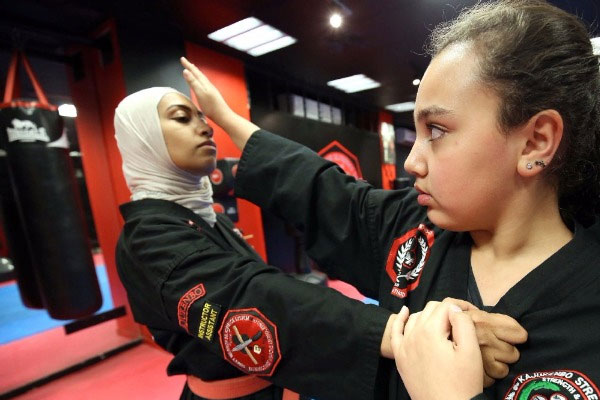Martial Arts Near Me
Kajukenbo
Kajukenbo, a dynamic and powerful form of self-defense, is a martial art born from the fiery mix of various traditional martial arts styles. Created in the late 1940s in Hawaii, Kajukenbo stands as a testament to the ingenuity, adaptability, and perseverance of its founders. Combining elements of Karate, Judo, Kenpo, and Boxing, among others, Kajukenbo flourished thanks to its practicality, effectiveness, and emphasis on real-world combat. Over the years, Kajukenbo has grown and evolved, spreading its influence worldwide, while remaining true to its roots and the spirit of innovation that birthed it. Today, Kajukenbo continues to inspire practitioners to push their limits, embrace self-improvement, and cultivate a warrior spirit.
The history of Kajukenbo begins in post-World War II Hawaii, during a time when gang violence was rampant, especially in the Palama Settlement area of Honolulu. Five visionary martial artists, Peter Young Yil Choo, Frank Ordonez, Joe Holck, Adriano Emperado, and Clarence Chang, became determined to find an effective way to protect themselves and their community from the escalating violence. Each of them was well-versed in different martial arts styles, such as Tang Soo Do, Judo, Boxing, and Kenpo, which served as the foundation for their unique collaboration.
The name "Kajukenbo" itself reflects the synthesis that birthed the art, combining elements from the original styles contributed by its founders. "KA" stands for Karate, "JU" for Judo and Jiu-Jitsu, "KEN" for Kenpo, and "BO" for Boxing. Together, these styles merged in a beautifully harmonious and combative blend, creating a martial art that is both practical and adaptable, incorporating both striking and grappling techniques.

One of the central principles of Kajukenbo is the constant search for practicality. Its founders sought to distill the essence of each contributing style, discarding ineffective or inefficient techniques, and emphasizing techniques that worked in real-world situations. The art evolved through constant testing and refinement, with each founder contributing their unique insights and experiences gained from their respective backgrounds. This spirit of continuous adaptation and experimentation has become an inherent characteristic of Kajukenbo.
Kajukenbo's techniques reflect its eclectic origins. Striking techniques from Karate and Boxing form a core aspect of its arsenal, delivering powerful punches, kicks, knees, and elbows. Fluid movements and evasive footwork allow practitioners to develop a strong offense, while simultaneously protecting themselves from incoming attacks. The influence of Judo and Jiu-Jitsu brings throws, joint locks, and submissions into the mix, expanding the practitioner's arsenal and making them equally formidable in close-quarters combat.
Kajukenbo training emphasizes both physical and mental development. Physical workouts involve intense conditioning, strength training, and endurance exercises to build a strong and agile body. Conditioning drills, such as pad work, sparring, and bag training, develop precision, timing, and power. Mental discipline is cultivated through rigorous training, fostering focus, resilience, and the ability to remain calm in high-pressure situations.
Thanks to its efficacy and practicality, Kajukenbo has gained popularity worldwide, spreading beyond its Hawaiian origins. Kajukenbo schools can now be found across the United States, Europe, Asia, and many other parts of the world. As the popularity of mixed martial arts (MMA) surged, many MMA fighters sought to incorporate Kajukenbo into their training regimen, recognizing the potential it offered to enhance their combat skills. This led to a further expansion and recognition of Kajukenbo as a viable and effective martial art.
In addition to its practicality, Kajukenbo also promotes personal growth, self-discipline, and the development of character. Students are encouraged to embody the warrior spirit, not solely for the purpose of self-defense, but also to transcend personal challenges and become better individuals. By promoting mental resilience, respect for oneself and others, and the pursuit of excellence, Kajukenbo becomes a vehicle for personal transformation.
In the modern martial arts landscape, Kajukenbo remains a vibrant and ever-evolving system. As more practitioners continue to contribute their experiences and insights, new variations and styles of Kajukenbo emerge. These variations might emphasize different aspects of the art, such as self-defense, sport competition, or spiritual growth. However, the essence of Kajukenbo always remains true to its roots: a fusion of various martial arts styles, blending practicality, efficiency, and adaptability.
Kajukenbo stands as a testament to the power of innovation and collaboration. Born from the crucible of gang violence, Kajukenbo's founders crafted a unique martial art that blended the best of various styles to create a truly effective and practical system. Its techniques, rooted in Karate, Judo, Kenpo, and Boxing, emphasize both striking and grappling, making it a well-rounded martial art that prepares practitioners for real-world combat. As Kajukenbo continues to thrive and expand globally, it remains a symbol of versatility, personal growth, and the indomitable spirit of its founders.